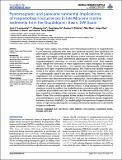Por favor, use este identificador para citar o enlazar a este item:
http://hdl.handle.net/10261/95998COMPARTIR / EXPORTAR:
 SHARE SHARE
 CORE
BASE CORE
BASE
|
|
| Visualizar otros formatos: MARC | Dublin Core | RDF | ORE | MODS | METS | DIDL | DATACITE | |

| Campo DC | Valor | Lengua/Idioma |
|---|---|---|
| dc.contributor.author | Larrasoaña, Juan C. | - |
| dc.contributor.author | Liu, Qingsong | - |
| dc.contributor.author | Hu, Pengxiang | - |
| dc.contributor.author | Roberts, Andrew P. | - |
| dc.contributor.author | Mata Campo, Maria Pilar | - |
| dc.contributor.author | Civis Llovera, Jorge | - |
| dc.contributor.author | Sierro, Francisco Javier | - |
| dc.contributor.author | Pérez-Asensio, José Noel | - |
| dc.date.issued | 2014-03 | - |
| dc.identifier.citation | Frontiers in Microbiology 5: 71-85 (2014) | es_ES |
| dc.identifier.issn | 1664-302X | - |
| dc.identifier.uri | http://hdl.handle.net/10261/95998 | - |
| dc.description.abstract | Although recent studies have revealed more widespread occurrences of magnetofossils in pre-Quaternary sediments than have been previously reported, their significance for paleomagnetic and paleoenvironmental studies is not fully understood. We present a paleo- and rock-magnetic study of late Miocene marine sediments recovered from the Guadalquivir Basin (SW Spain). Well-defined paleomagnetic directions provide a robust magnetostratigraphic chronology for the two studied sediment cores. Rock magnetic results indicate the dominance of intact magnetosome chains throughout the studied sediments. These results provide a link between the highest-quality paleomagnetic directions and higher magnetofossil abundances. We interpret that bacterial magnetite formed in the surface sediment mixed layer and that these magnetic particles gave rise to a paleomagnetic signal in the same way as detrital grains. They, therefore, carry a magnetization that is essentially identical to a post-depositional remanent magnetization, which we term a bio-depositional remanent magnetization. Some studied polarity reversals record paleomagnetic directions with an apparent 60-70 kyr recording delay. Magnetofossils in these cases are interpreted to carry a biogeochemical remanent magnetization that is locked in at greater depth in the sediment column. A sharp decrease in magnetofossil abundance toward the middle of the studied boreholes coincides broadly with a major rise in sediment accumulation rates near the onset of the Messinian salinity crisis (MSC), an event caused by interruption of the connection between the Mediterranean Sea and the Atlantic Ocean. This correlation appears to have resulted from dilution of magnetofossils by enhanced terrigenous inputs that were driven, in turn, by sedimentary changes triggered in the basin at the onset of the MSC. Our results highlight the importance of magnetofossils as carriers of high-quality paleomagnetic and paleoenvironmental signals even in dominantly terrigenous sediments. | es_ES |
| dc.description.sponsorship | This study was funded by the Guadaltyc project(MINECO,CGL2012–30875), ARC grant DP120103952,and NSFC grant 41374073. | es_ES |
| dc.language.iso | eng | es_ES |
| dc.publisher | Frontiers Media | es_ES |
| dc.relation.isversionof | Publisher's version | es_ES |
| dc.rights | openAccess | es_ES |
| dc.subject | Guadalquivir Basin | es_ES |
| dc.subject | Late Miocene | es_ES |
| dc.subject | Magnetotactic bacteria | es_ES |
| dc.subject | Marine sediments; | es_ES |
| dc.subject | Messinian salinity crisis | es_ES |
| dc.subject | Rock magnetism | es_ES |
| dc.title | Paleomagnetic and paleoenvironmental implications of magnetofossil occurrences in late Miocene marine sediments from the Guadalquivir Basin, SW Spain | es_ES |
| dc.type | artículo | - |
| dc.identifier.doi | 10.3389/fmicb.2014.00071 | - |
| dc.description.peerreviewed | Peer reviewed | es_ES |
| dc.relation.publisherversion | http://dx.doi.org/10.3389/fmicb.2014.00071 | es_ES |
| dc.identifier.pmid | 24624124 | - |
| dc.type.coar | http://purl.org/coar/resource_type/c_6501 | es_ES |
| item.cerifentitytype | Publications | - |
| item.openairecristype | http://purl.org/coar/resource_type/c_18cf | - |
| item.grantfulltext | open | - |
| item.openairetype | artículo | - |
| item.fulltext | With Fulltext | - |
| item.languageiso639-1 | en | - |
| Aparece en las colecciones: | (Geo3Bcn) Artículos (IGME) Artículos | |
Ficheros en este ítem:
| Fichero | Descripción | Tamaño | Formato | |
|---|---|---|---|---|
| Cruz Larrasoaña 2014 frontiers in Microbiology 5 71 1.pdf | 3,02 MB | Adobe PDF |  Visualizar/Abrir |
CORE Recommender
PubMed Central
Citations
7
checked on 30-abr-2024
SCOPUSTM
Citations
40
checked on 29-abr-2024
WEB OF SCIENCETM
Citations
39
checked on 23-feb-2024
Page view(s)
284
checked on 03-may-2024
Download(s)
371
checked on 03-may-2024
Google ScholarTM
Check
Altmetric
Altmetric
Artículos relacionados:
NOTA: Los ítems de Digital.CSIC están protegidos por copyright, con todos los derechos reservados, a menos que se indique lo contrario.
